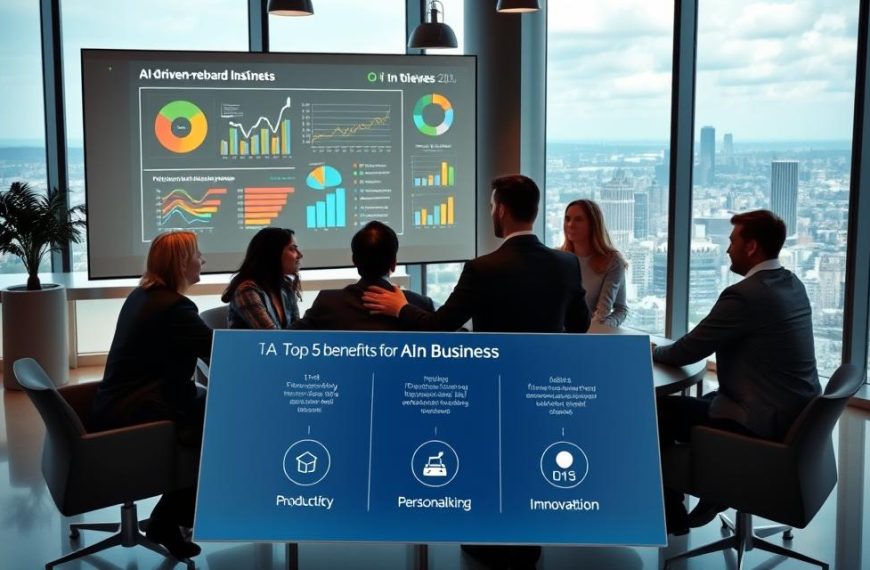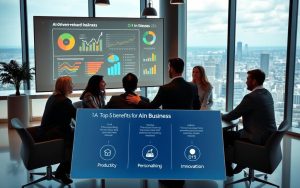Modern organisations now view advanced technologies as essential tools for growth. With nearly 90% of business leaders prioritising investments in machine learning and automation, these systems are reshaping how companies operate. By analysing customer behaviours and market trends, AI delivers actionable insights that drive smarter strategies.
Core components like natural language processing and deep learning enable machines to interpret complex data sets. This capability allows businesses to segment audiences with precision, personalise services, and forecast emerging opportunities. The global market for these technologies is projected to exceed $826 billion by 2030, reflecting their critical role in maintaining competitiveness.
Forward-thinking firms leverage AI beyond basic automation. Optimising supply chains, enhancing decision-making processes, and refining customer interactions represent key focus areas. These applications not only boost efficiency but also create tailored experiences that foster brand loyalty.
Adoption trends reveal a clear shift: what began as experimental tools now form the backbone of strategic planning. From product development to service delivery, intelligent systems help organisations stay ahead in fast-paced markets. This evolution underscores why AI has transitioned from novelty to necessity in modern commerce.
Understanding the AI Revolution in Business
Corporate strategies now rely on intelligent systems that reshape operational frameworks. Three core machine learning approaches drive this shift: supervised, unsupervised, and reinforcement learning. These algorithms process historical data to forecast inventory needs, customer churn rates, and equipment failures with growing accuracy.
Overview of AI Technologies and Trends
Natural language processing solutions decode customer feedback across emails and social platforms, identifying sentiment patterns. Emerging trends like swarm learning enable collaborative model training without sharing sensitive data. Generative AI tools now draft marketing copy and design prototypes, accelerating creative workflows.
Impact on Modern Business Functions
Key operational areas benefit from automation and predictive capabilities:
- HR departments screen CVs using pattern recognition systems
- Manufacturing plants deploy vision algorithms for quality control
- Retailers personalise promotions through real-time basket analysis
Embedded analytics transform raw IoT sensor data into maintenance alerts, preventing downtime. This convergence of technology creates adaptive products that learn user preferences, from smart thermostats to fleet management solutions.
What is the role of artificial intelligence in the business
Advanced systems act as catalysts for organisational transformation, redefining how companies interact with information. By processing millions of data points daily, these tools uncover hidden correlations in customer behaviour, from browsing habits to loyalty triggers. Retailers leverage these insights to adjust pricing strategies in real-time, while service providers personalise offerings based on individual engagement histories.

Pattern recognition capabilities enable firms to identify patterns in supply chain disruptions or production bottlenecks. Manufacturers use sensor data to predict equipment maintenance needs, reducing downtime by up to 45%. Financial institutions apply similar techniques to detect fraudulent transactions, safeguarding both business interests and client assets.
Predictive analytics revolutionises decision-making across departments. Marketing teams forecast campaign performance with 89% accuracy, while HR departments anticipate staff retention risks. These systems analyse historical data alongside market signals, providing actionable recommendations for resource allocation.
Operational efficiency gains emerge through intelligent automation of repetitive tasks. Logistics companies optimise delivery routes using real-time traffic data, cutting fuel costs by 18-22%. Customer service teams deploy chatbots handling 70% of routine enquiries, freeing staff for complex cases requiring human empathy.
The convergence of machine learning and big data creates adaptive business processes that evolve with market demands. From dynamic inventory management to AI-driven risk assessment models, organisations achieve unprecedented responsiveness. This agility proves vital in maintaining competitiveness within rapidly shifting commercial landscapes.
Leveraging Machine Learning and Natural Language Processing in Business
Cutting-edge computational methods now power critical operational decisions across industries. Over 67% of UK enterprises report improved efficiency through tailored machine learning algorithms, transforming raw data into strategic assets.
Deep Dive into Machine Learning Algorithms
Three primary learning algorithms drive business innovation:
| Algorithm Type | Business Application | Industry Use |
|---|---|---|
| Supervised | Demand forecasting | Retail |
| Unsupervised | Customer segmentation | Banking |
| Reinforcement | Dynamic pricing | Logistics |
Advanced techniques like Named Entity Recognition scan documents for locations, brands, and personnel. This enables automated contract reviews and competitive analysis.
Natural Language Processing: Tools and Trends
Modern natural language processing systems decode sentiment in customer emails and social posts.
“Semantic search tools now answer complex queries 40% faster than traditional keyword matching,”
notes a Cambridge AI researcher.
Key applications include:
- Real-time translation for global client meetings
- Chatbots resolving 73% of routine enquiries
- Automated report generation from raw data
Emerging tools like federated learning allow collaborative model training without sharing sensitive data. AutoML platforms further democratise access to language processing capabilities, empowering non-technical teams.
AI-Driven Marketing and Customer Engagement Strategies
Modern marketing teams harness intelligent systems to craft hyper-targeted campaigns. Over 76% of UK brands now use social listening tools to decode audience sentiment, transforming casual mentions into strategic insights. This approach enables real-time adjustments to content strategies and brand positioning.

Social Listening and Content Personalisation
Platforms like Sprout Social analyse millions of social media interactions daily. These systems identify emerging trends before they peak, allowing marketers to capitalise on viral moments. Netflix’s recommendation engine exemplifies success, driving 80% of viewer engagement through personalised suggestions.
Advanced algorithms cross-reference browsing history with demographic data. This creates tailored experiences that boost customer engagement by 34% across retail sectors. Competitor analysis tools track rival campaigns, measuring audience growth and content resonance.
Predictive Analytics for Targeting and Media Buying
Automated systems forecast purchasing patterns with 87% accuracy. Volkswagen’s media team uses these insights to allocate budgets across high-performing channels. Real-time bidding algorithms assess media placement effectiveness, improving ROI by 22-29%.
| Metric | Traditional Approach | AI-Driven Strategy |
|---|---|---|
| Campaign Planning | Manual trend analysis | Real-time predictive modelling |
| Ad Spend Efficiency | 34% conversion rate | 51% conversion rate |
| Customer Retention | 6-month feedback cycles | Instant sentiment adjustments |
Chatbots handle 68% of routine customer queries, freeing teams for complex issues. Email campaigns adapt content based on individual open rates and click patterns. These strategies create dynamic feedback loops that refine marketing approaches continuously.
Innovating Product Development with AI Enhancements
Forward-looking companies are reimagining product lifecycles through intelligent systems. These tools analyse customer behaviour, market shifts, and operational data to refine design processes
Redesigning Product Design and Project Management
Automotive manufacturers now use generative design algorithms to create lighter, safer components. These systems evaluate thousands of material combinations in hours – a task requiring weeks of manual analysis. Retail giants leverage similar technology to prototype packaging that reduces shipping costs by 17-24%.
| Development Phase | Traditional Approach | AI-Driven Method | Impact |
|---|---|---|---|
| Concept Design | Manual market research | Real-time trend prediction | 38% faster time-to-market |
| Testing | Physical prototypes | Simulated stress analysis | 62% cost reduction |
| Maintenance | Scheduled inspections | Predictive failure alerts | 41% fewer downtime incidents |
Project management teams achieve 29% higher efficiency through AI-powered tools. These platforms automatically allocate resources based on team workloads and project complexity. Real-time dashboards highlight potential bottlenecks before they delay timelines.
Leading UK firms report 55% faster iteration cycles when using AI product development strategies for rapid prototyping. Machine learning models test virtual product variants against historical performance data, identifying optimal features early in the design process.
Streamlining Sales, Operations and Human Resources with AI
Intelligent automation now drives operational excellence across key departments. Over 82% of UK firms report measurable efficiency gains through AI-powered systems in sales pipelines and workforce management. These tools transform routine tasks into strategic opportunities.

Automating Sales and Lead Scoring Processes
Advanced algorithms analyse customer interactions to prioritise high-value prospects. Email campaigns using behavioural data achieve 37% higher open rates through personalised subject lines. Dynamic lead scoring models process:
- Purchase history patterns
- Website engagement metrics
- Social media sentiment signals
Heineken’s operations team reduced excess stock by 24% using machine learning for demand forecasting. Their system cross-references weather patterns, event schedules, and regional sales data to optimise deliveries.
| Department | Traditional Method | AI Solution | Outcome |
|---|---|---|---|
| Sales | Manual lead ranking | Predictive scoring | 51% faster conversions |
| Operations | Static inventory rules | Smart restocking | 18% cost reduction |
| HR | CV keyword searches | Skill matching algorithms | 42% hire quality improvement |
Unilever’s recruitment processes demonstrate AI’s HR potential. Their video analysis tools assess candidate responses while filtering unconscious bias. This approach increased workforce diversity by 33% across European branches.
Administrative automation frees 11 hours weekly for teams to focus on strategic initiatives. Chatbots handle routine payroll queries, while smart scheduling systems optimise shift patterns based on real-time demand.
Enhancing Business Security and Fraud Detection with AI
Cyber defence strategies now integrate advanced algorithms that identify threats 74% faster than traditional methods. With the cybersecurity AI market projected to hit £30.1 billion by 2026, UK companies prioritise real-time monitoring to safeguard digital assets. These systems analyse petabytes of data, spotting subtle patterns in network traffic or transaction logs that human teams might miss.

Monitoring Media Threats and Identifying Anomalies
Proactive detection tools scan dark web forums and social platforms for brand impersonation attempts. Mastercard’s security solution exemplifies this approach – their AI flags suspicious payments within 50 milliseconds, preventing £2.3 billion in annual fraud.
“Our neural networks process 160 transaction variables simultaneously,”
explains a Mastercard cybersecurity lead.
Three critical advancements define modern systems:
- Behavioural biometrics analysing typing rhythms
- Predictive models updating threat databases hourly
- Automated incident response triggering containment protocols
| Approach | Traditional | AI-Driven |
|---|---|---|
| Fraud Detection | 7-day investigation cycles | Real-time blocking |
| Threat Analysis | Manual log reviews | Anomaly alerts |
| False Positives | 42% rate | Under 9% rate |
Machine learning algorithms adapt to new attack vectors, reducing response times by 68% in UK financial institutions. Continuous monitoring of customer data flows helps organisations stay ahead of evolving cyber threats while maintaining regulatory compliance.
Developing a Sustainable AI Business Strategy for Future Growth
Sustainable success demands strategic alignment between emerging technologies and organisational goals. Forward-thinking business leaders prioritise decision intelligence systems that convert predictive analytics into operational actions. This approach transforms raw data into competitive advantages across supply chains and customer engagement channels.
Integrating AI into Core Business Processes
Adopting strategies like swarm learning allows interconnected systems to share insights without compromising sensitive information. Embedded analytics tools automate workflow adjustments, from inventory management to service personalisation. Over 68% of UK companies report improved agility through real-time trend adaptation in core operations.
Preparing Employees and Upholding Ethical AI Standards
Reskilling programmes equip teams to collaborate effectively with intelligence tools, addressing skill gaps in data literacy. Robust governance frameworks ensure algorithmic transparency and bias mitigation. Regular audits maintain public trust while aligning AI deployments with evolving UK regulatory trends.
Building future-ready business models requires continuous investment in adaptive learning systems and ethical infrastructure. Organisations mastering this balance will lead markets where technological prowess and social responsibility converge.










